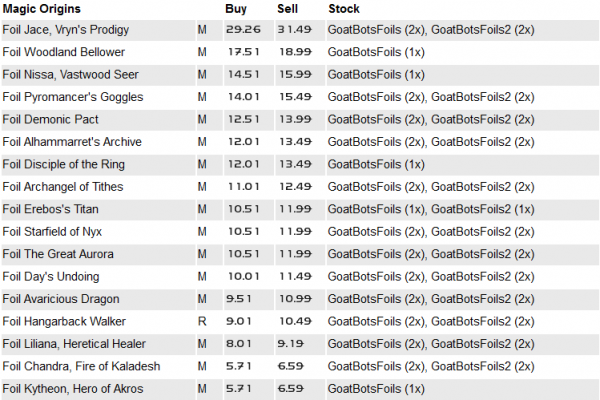Are you a Quiet Speculation member?
If not, now is a perfect time to join up! Our powerful tools, breaking-news analysis, and exclusive Discord channel will make sure you stay up to date and ahead of the curve.
Welcome back to my discussion of foil mythic rares on MTGO. In Part 1, I laid out the basic questions raised by the odd price behavior of foil mythics. Today we'll start to explain these phenomena through the lens of redemption.
The Theory of Redemption
Through the mechanism of redemption, players can redeem digital sets on MTGO for a factory sealed paper set. This applies to complete sets of foils too, which means that the online and paper full set values are approximately the same.
Mythic rares are ‘printed’ at about half the rate of regular rares, which means mythic rares are the bottleneck to redeeming a digital set into paper. Since only a complete set can be redeemed, the rarest parts of the whole set are the ones that hold the most value, even if the paper prices on individual cards are wildly different from MTGO prices. This is what makes even junk mythic rares hold a little value; you still need the junk mythic rares in order to redeem a complete set.

Next, foil mythic rares are generally expensive relative to their non-foil counterparts. If you look at the list of foil mythic rares in the above screenshot, every foil mythic rare is more expensive than its non-foil counterpart. The foil multiplier on Jace is about 5%; but for a card like Disciple of the Ring, which currently goes for 0.59 tix, the foil is over 20 times more expensive than the regular version. That is quite the multiplier!
The Theory of Redemption Applied to Foils
This discrepancy in the price of the foil and regular versions can explained by the theory of redemption, but there are a few extra factors to consider. The pool of value in a foil set is much bigger; with a foil set of ORI going for triple the regular set, this is obvious. It is still redemption that gives redeemable MTGO cards their value, and just like regular sets the bottleneck is still the mythic rarity. Therefore, foil mythic rares hold value just like regular mythic rares. But because the pool of value in a foil set is bigger, the average foil mythic rare holds more value too. Even the redemption fee of $25 is small potatoes when you are looking at a set priced at 300 tix.
The next question to consider is how the value and the price of a given mythic rare changes over time, a crucial factor when one is looking to buy or sell cards. In the case of the average mythic rare, the trend is down as more and more product is opened in drafts, and the price and value steadily decline over time as the supply grows.
There are always exceptions like constructed staples and shifting metagames that interrupt the trend, but for the most part it’s well understood that prices head down over time on the average mythic rare. Therefore, it is safest to buy the average mythic rare near the end of the drafting window for that particular card’s set. Peak supply is reached when new sets are released and the older set is no longer the current draft format.
However, this trend doesn’t apply to foil mythic rares on MTGO. I’ll repeat that. The downward trend in card prices does not apply to foil mythic rares on MTGO. This will take some unpacking to explain.
First, we’ll start with the observation that foil sets tend to hold their value and have stable prices over the medium term of 3 to 6 months, especially compared to the price of a regular set. With that as an observation/assumption, let’s consider the dynamics of how the price of the components of a foil set change over time. We’ll start by focusing on the cards that are not the bottleneck, the rares, uncommons and commons.
On MTGO, these cards are valued according to their utility. Anyone who pays attention to the MTGO economy knows that there are ton of cards being opened all the time, as we often see the price of junk rares falling to below 0.01 tix and junk uncommons and commons are basically worthless. They hold no value due to their ubiquity. Foils are a little rarer, so even a junk foil ORI common sells for 0.03 tix.
To think about why these foils are not valued on MTGO, consider that to play Magic you just need the game pieces you want for your deck. Since a foil has no extra functionality when compared to a regular version, foils and non foils are perfect substitutes for playing Magic. In the real world, paper foils have value to collectors and players because they like them better than regular versions, but on MTGO the special nature of foils is not a big factor.
When foil rares, uncommons and commons have perfect substitutes, that means that their price will track the price of the regular versions. Players will just play with the cheapest version, all things being equal. Thus, the price of rares, uncommons and commons all trend down along with the rest of the cards that get opened in draft, with only a very small premium associated with being a foil.
That covers most of the components of a foil set which tells us that most of the cards from a foil set are getting cheaper over time. As the price of the rares, uncommons and commons are falling over time, combined with a stable price of a complete foil set, then the foil mythic rares must be accruing the value that the other cards are losing. And this is exactly what is observed over time.
The Conclusion
Looking at our picture above, it is obvious that foil versions of junk mythic rares have a much higher price than one might otherwise expect. This is because mythic rares are still the bottleneck to redemption, but with a larger pool of value in a foil set and the price of the rest of the set falling, then over time foil mythic rares actually go up in price. This is contrary to how most players expect prices to act so it’s worth repeating. Over time, foil mythic rares tend to go up in price on MTGO.
~
Join me next week, where I'll outline an investment strategy for foil mythics which should generate enough profits to fund most MTGO accounts indefinitely.






Awesome article, Matt. Looking forward to next week!
Yes agree, to illustrate your purpose, few days ago, I got Den Protector foils for 6.7 each while the regular version was 8.5 (bought on goatbots), so in some cases, foil rares are cheaper than their regular counterpart.
I allready noticed this is no execption, you can easily find tens of rares in each standard set where this is the case… goatbots even highlights this by putting stars next to the cards when the foils are cheaper
and to make this even worse, the foil mutavault i once drafted is just worth half of his nonfoil brothers
I’ve been waiting a week for you to explain this after the cliffhanger last week, now that I read it it’s so simple that I can’t believe I didn’t think of it. Which is always the sign of a great idea. Well done, and looking forward to the next one!
Thanks! When I started writing the article, it became clearer and clearer to me that I was onto something substantial. I’m glad you agree.
Just read it again, thought about it, read it again, thought about it some more. Have a question: Where are you getting your data from? Because mtggoldfish didn’t track foils before Gatecrash, and even when it did, it seems that for somecards there are long periods where prices didn’t change, which usually indicates that mtgotraders was out of stock.
And how did you actually do the number crunching? It would be cool to be able to point to a graph which shows the prices of a foil set without the mythics, to confirm that it does go down over time, but that’s not possible with mtggoldfish at the moment. Kelly, if you’re reading, that would be one really cool feature to have!
I didn’t crunch numbers, just went with my gut initially and then with theorizing afterwards. The data is pretty sparse as I think it’s only in the last year that cardbot/mtgotraders have become competitive on foils.